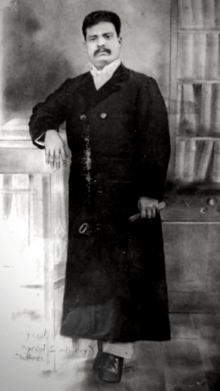Sayeed Mohammed
Sayeed Mohammed (native name : ସଇଦ୍ ମହମ୍ମଦ୍) (1891 - 1922) was an Indian Odia educationist and philanthropist from Cuttack. In 1913 he founded the Muslim Seminary (present day Sayeed Seminary) at Cuttack, which is regarded as the second nationalist school of Odisha. [1] Sayeed is known for his activism against the British in the early 1900s. He was one of the prominent members of the Utkal Sammilani. Sayeed along with Ekram Rasul co-founded the All Odisha Khilafat Committee in 1922.[2][3]
Sayeed Mohammed | |
|---|---|
 | |
| Born | August 25, 1891 Kamakhyanagar Dhenkanal, British Raj |
| Died | July 18, 1922 (aged 30) Cuttack, British India |
| Resting place | Qadam e Rasool, Cuttack |
| Citizenship | |
| Alma mater | Ravenshaw Collegiate School, Calcutta Madrasa |
| Occupation | Educationist |
| Spouse(s) | Begum Badar un nissa Akhtar |
| Children | Athar-ul Amin, Afzal-ul Amin, Fazal-ul Amin, Niharara Akhtar, Husanara Begum |
| Parent(s) | Atharuddin Mohammed (father) Nadeera Sultana (mother) |
| Relatives | Hussain Rabi Gandhi (grandson in law)
Sultana Farhat Amin (granddaughter) Sultana Razia Rasool (granddaughter) |
Early Life and Career
Janab Maulana Sayeed Mohammed was born at Kamakhyanagar, into the Diwan family of Dhenkanal, to Atharuddin Mohammed and his senior wife (Badi Bahu Begum), Begum Nadeera Sultana. Sayeed's father was the ruling chief of Kamakhyangar and also the Diwan of Dhenkanal during Raja Shura Paratap Mahendra Bahadur's rule. [4] Sayeed moved to Cuttack in order to attain formal education. After studying at Ravenshaw Collegiate School, he joined the Utkal Sammilani. Both he and his father made attempts to unify the Odia speaking tracts by working for the Sammilani. In Cuttack, Sayeed emerged as a local leader and started to serve the Muslim community. He led the Odia muslims to participate in the Indian freedom struggle.
Later Sayeed earned a scholarship in Persian studies and Arabic from Calcutta Madrasa and after earning degrees in the respective subjects, he was appointed as an assistant teacher at Victoria high school, Cuttack by the British government. Being a nationalist, he also worked in close association with Gopabandhu Das, Bhakta kabi Madhusudan Rao and Radhanath Rath, the editor of Samaja. In 1908 Sayeed organized and led various mass protests against the British government regarding the new provision introduced by the British, which provided limited and separate reservation of seats for Muslim and Hindu students in schools at the time of admission.[5] Because of his participation in the nationalist movements against the British government, he along with some of his other Indian colleagues at Victoria high school, who were nationalists too, were asked to resign from their respective positions. It was during this period when Gopabandhu Das established the first nationalist school in Odisha called the Satyabadi Bana Bidyalaya at Sakhigopal, Puri in 1909.[6][7]
Sayeed saw this as an excellent idea to educate and uplift Indian children without actually serving or working under the British; thus he along with his expelled colleagues established a new nationalist school called the 'Muslim Seminary' in 1913 at Cuttack for Indian students.. Sayeed co-founded the All Odisha Khilafat Committee in 1922 before his death.
Marriage and Family
Sayeed married Begum Badar un nissa Akhtar, the only daughter of Aminuddin Al Amin Suhrawardy and the granddaughter of Ubaidullah Al Ubaidi Suhrawardy. The couple bore five children (three sons and two daughters). After Sayeed's early death, Begum Badr continued to work for the Muslim community in Cuttack. She particularly emphasized on female education.
Sayeed Seminary
The school started from a rented building with 500 students on its roll. It was largely dependent on donations. Meanwhile, Sayeed managed to persuade a generous merchant of Madras, C. Abdul Hakeem to donate the present land and building. Even the Nizam of Hyderabad, Mir Osman Ali Khan made a monthly grant of Rs 50.[8]
After the partition of 1947, its name was changed from 'Muslim Seminary' to 'Sayeed Seminary' in order to throw a more secular light at it. Sayeed Seminary became a reputed high school in the city, that offered education to both Muslim and Hindu students in Urdu and Odia. The school has produced many distinguished alumni including, Mohammad Mohsin, Sushil Kumar Sinha (scientist), Abdul Majid (sportsperson), S.M. Osatullah (I.A.S) and Mustafiz Ahmed (Minister).[8]
References
- "SAYEED SEMINARY HS - Ward No.17, District Cuttack (Orissa)". schools.org.in. Retrieved 10 April 2020.
- Das, Manas Kumar. NATIONALIST MOVEMENT IN ODISHA. Lulu.com. ISBN 978-0-359-78858-3.
- ACHARYA, PRITISH; KRISHAN, SHRI (2010). "An Experiment in Nationalist Education: Satyavadi School in Orissa (1909-26)". Economic and Political Weekly. 45 (51): 71–78. ISSN 0012-9976.
- Rathore, Abhinay. "Dhenkanal (Princely State)". Rajput Provinces of India. Retrieved 10 April 2020.
- Sayeed Seminary School. "Sayeed Seminary, Odisha's AMU".
- "Fani Aftermath:Satyabadi Bana Bidyalaya loses substantial green cover - OrissaPOST". Odisha News, Odisha Latest news, Odisha Daily - OrissaPOST. 12 May 2019. Retrieved 10 April 2020.
- "Odisha govt to set up Odia University at Satyabadi in Puri - Times of India". The Times of India. Retrieved 10 April 2020.
- Jaffrelot, Christophe; Gayer, Laurent (1 December 2013). Muslims In Indian Cities : Trajectories Of Marginalisation. HarperCollins Publishers India. ISBN 978-93-5029-555-7.